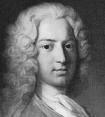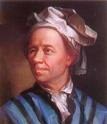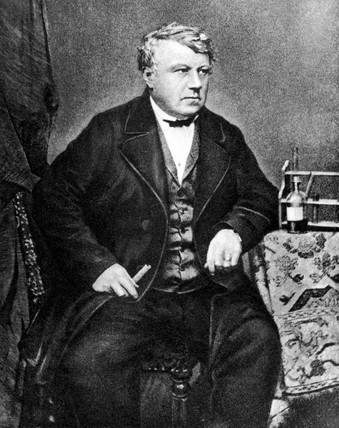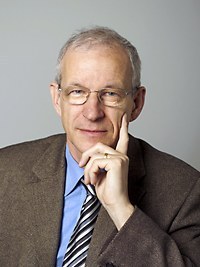Natural scientists
The Bernoullis: a dynasty of mathematicians and physicians
The Protestant family Bernoulli fleed in 1583 from the massacres of Catholics from Antwerp to Basel. They were rich and successful business people. Among the descendants of Nikolaus Bernoulli, we can find eight mathematicians and one physicist, all of the utmost importance and all but one attended the Humanistisches Gymnasium! Johann I became even Principal and carried out important reforms . This mathematician dinasty made decisive contributions to the development of differential and integral calculus which go far beyond Newton and Leibnitz.
Daniel Bernoulli
The famous flow equation is nothing more than the energy principle formulated for a volume unit of a vortex-free flow of an idealized gas or liquid. The first term is the 'dynamic pressure' acting only in the direction of flow. It describes the kinetic energy of the flow per cubic meter of gas. The second term is the static pressure acting in all directions through the compressed gas and represents, so to speak, the elastic energy of the flow per cubic meter. The third term stands for the gravitational pressure of the gas for different altitudes above sea level, and describes the potential energy per cubic meter.
In the aircraft wing, the gravity pressure does not matter, because the height of the flow is (almost) constant. On the upper side of the wing, the speed of the flow increases because of the longer way. This increases the dynamic pressure while at the same time the static pressure decreases. The higher static pressure below pushes the wing upwards.
Without the flow equation of the physicist Daniel Bernoulli, aircrafts could not fly at all.
Jakob Bernoulli I (1655-1705)
Jakob I was the son of the spice merchant Nicolaus Bernoulli and his wife Margarethe Schönauer, and brother of the mathematician Johann Bernoulli. After attending the Gymnasium auf Burg, he studied Philosophy and Theology at the University of Basel. In 1671 he achieved the master's degree and in 1676 the licentiate in Theology.He pushed his knowledge in mathematics and astronomy almost autodidactically and against his father's will. In 1687 he was appointed professor of Mathematics at the University of Basel and began, together with his younger brother and pupil Johann Bernoulli, to work on the infinitesimal calculus of Leibniz.By 1689, Johann had published important works on power series and probability calculus, i.a. the Law of large numbers. In the early 1690s he worked mainly in the field of calculus of variations. In 1699, James I became a member of the Académie des Sciences of Paris and two years later he entered the Akademie der Wissenschaften of Berlin.
He is the author of Bernoulli's inequality, an inequality hated by many students, but often used.
Leonhard Euler (1707-1783)
Born in Basel, this infamous mathematician grew up in Riehen, a suburb of Basel. His parents' house is next to the Riehen church.
The vast majority of Euler's work is of such a high standard that it can only be understood by professionals. That is why only two with his many insights, known to most high school students, are presented here.
The best known is probably Euler's number e. It is irrational and can only be defined as the limit of a sequence of numbers:
Unfortunately, the sequence defined in this way converges only very slowly towards e. You get:
for n = 1: 2.000000000000000
for n = 10: 2.593742460100000
for n = 100: 2.704813829421526
for n = 1000: 2.716923932235893
The Euler line is also very well known. In each triangle that is not equilateral, the vertical intersection H, the center of gravity S, and the perimeter U lie on a single straight line.
The center of gravity S divides the distance between the vertical intersection point H and the center of circumference U in the ratio 2: 1.
Christian Friedrich Schönbein (1799-1868)
Schönbein gave the lecture for experimental chemistry in Basel from 1827 on, and became full professor of chemistry and physics in Basel in 1835. At the same time, he worked as Physics and Chemistry teacher at the Humanistisches Gymnasium. Schönbein was more than just a scientist. He took an active part in the political life of the city and also worked as a journalist.
In 1839 he discovered the 3-atom, very reactive variant of oxygen, the ozone. Ozone is a good UV filter. In the upper atmosphere, it is vital to us. Below, ozone irritates the respiratory system.
Unfortunately, our way of life causes two problems regardin ozone: Near the ground, the combustion products of fossil fuels generates too much ozone under the influence of the sun, and in the high atmosphere, the chlorine-processing industry destroys the vital ozone layer.
Schoenbein became known worldwide through the invention of Nitrocellulose. Guncotton is much more efficient than the black powder used until then for ammunition.
Recipe: CAUTION !:
Bath Cottonwood in 'Nitrating Acid' (see Chemistry book) for 2-3 minutes (use the fume Hood and goggles!).
Wash well (attention: hands, clothes).
Dry well. Light only small quantities.
In 1999, on the occasion of the Christian Friedrich Schönbein Year, a big ceremony took place in the University of Basel with a speech by Nobel Prize winner Rowland and a Schönbein exhibition in the Natural History Museum.
Ralph Eichler
Former President of the ETH Zürich
- Attended the Gymnasiums am Münsterplatz Basel
- Studies and doctorate in Physics from ETH Zürich
- 1976-1981 researcher at Stanford University, subsequently at DESY (Deutsches Elektronen-Synchrotron)
- 1982-1989 Research Associate at the Institute of Intermediate Energy Physics at the ETH Zurich,
- Research Projects at the Schweizerisches Institut für Nuklearphysik and Project Leader at the Paul Scherrer Institute.
- 2002-2007 Director of the Paul Scherrer Institute
- Since 1989 Professor für Physik at ETH Zürich
- 1995-1997 Manager of the international collaboration H1 at DESY in Hamburg
- 1998-2002 Deputy Director of the PSI, Villigen
- July 2002 - August 2007 Director of the PSI, Villigen
- Since January 2004 Member of the Board of the ETH
- 2007-2014 President of ETH Zürich






